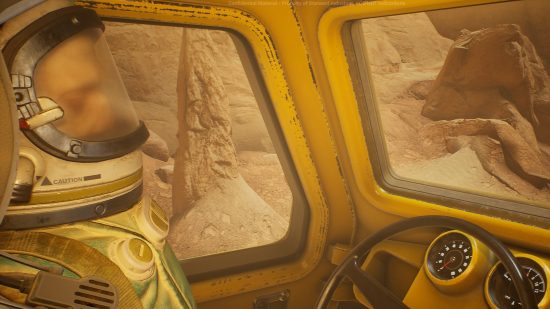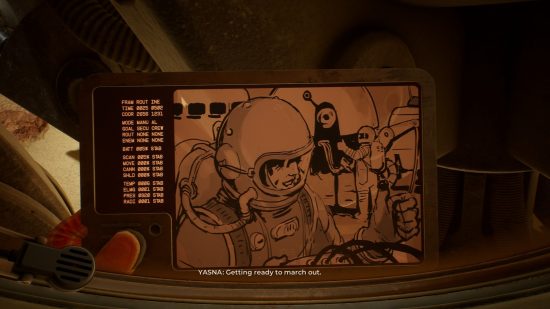As my hands-on preview of sci-fi adventure game The Invincible opens, my screen fills with the view through the scuffed visor of a space helmet. It’s the kind from classic science fiction paperback covers, the ones the first Lego astronauts wore. I’m looking at a sandstone canyon on an alien planet – one that has apparently claimed the lives of my colleagues aboard our sister ship, Condor.
The Invincible is a direct adaptation of of landmark novel of the same name by Polish author and futurist Stanisław Lem. Published in 1964, it’s a thrilling story about a first encounter with alien life. Unlike the familiar bipedal extraterrestrials Lem’s contemporaries frequently imagined, the aliens found on the planet Regis III are entirely unlike human beings. This is beyond not speaking the language – there are much more fundamental problems than communication at play here.
It’s an eerily prescient book that holds up well almost 60 years later. In the roughly one-hour demo, I play as astrobiologist Yasna, and I’m heading into this canyon to search for a lost convoy missing from the Condor. So far, we’ve found no survivors from the original expedition.

The Invincible is startlingly realistic in its graphics, yet fully committed to its retro-future aesthetic. The glare from the alien sun refracts in my visor, and I have separate scientific instruments with oversized ’60s-style LEDs and big handles for each distinct task. One lets me search for nearby space suit transponders, another allows me to scan for metal deposits in the nearby landscape, displaying what it sees on a glowing green screen on its back.
Regis III is a desert planet, and the action takes place in and around the sandstone canyons. These form a complex labyrinth, and as I explore them it’s clear that the members of the convoy had grown frustrated trying to find their way – they seem to have used a self-propelled antimatter cannon to bore a perfectly circular tunnel through the canyons when they reached a dead end.
Yasna relays her observations to a contact aboard the Invincible. Their banter keeps the trek from feeling too lonely, at least until we stumble across the mummified corpses of the Condor’s crew – one half-buried next to the wreckage of the antimatter robot. His desiccated face sightlessly stares out through a plastic visor just like mine, and suddenly it feels very lonely out here indeed.
The crew of the Invincible are scientists, not space marines, and this is a forensic game that unfolds slowly. In each key area I find, there are points of interest – the remains of a member of the Condor, or a panel on the hulking antimatter robot, for example. Each of these is highlighted by a small UI element, which I can select to pull up a short list of options. Yasna can note these discoveries and make some remarks back to base, or choose to remain silent.
Each interaction with a machine in The Invincible involves physically moving big levers, turning big knobs, or pressing big buttons. Every time I twist the handle on the door to a rover, there’s a satisfying clunk as it reaches the end of the action – Regis III has an atmosphere, so there’s air for sound waves to travel through here.
Between the convincing and beautiful visuals, excellent sound design, and deliberate sense of pacing, The Invincible appears committed to getting the details right – at least, in most cases. At one point, I open the visual logs of a broken robot, and the photographic record is presented as a series of hand-drawn illustrations. It’s a curious choice that stands out from the photorealism of the rest of the demo – it’s as if the spider-like robot carries a courtroom sketch artist instead of an actual camera.
Yasna acts as if this is totally normal, and the dissonance is a bit jarring. It’s certainly not a deal-breaker, but it’s a choice that shakes me out of the immersion that The Invincible had been carefully building up to that point.
Overall, though, Starward Industries’ vision of The Invincible seems like it’s shaping up to be a great way to experience the groundbreaking science fiction novel, which itself is a story well worth visiting. Having read it recently, I was routinely impressed by how current its ideas feel – The Invincible anticipates discussions we’re having now, decades later, about inorganic life, AI, and nanomachines.
If you’re a fan of hard sci-fi and prefer thrillers to thrill rides, keep an eye out when The Invincible release date arrives in 2023 – you can find it now on Steam. In the meantime, have a look at our list of the best space games on PC, which will help scratch that explorer’s itch.



